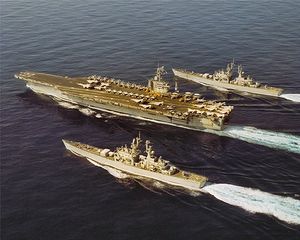Nimitz-class: Difference between revisions
Jump to navigation
Jump to search
imported>Robert A. Estremo m (add image) |
mNo edit summary |
||
| (4 intermediate revisions by 2 users not shown) | |||
| Line 1: | Line 1: | ||
{{subpages}} | {{PropDel}}<br><br>{{subpages}} | ||
[[Image:Nimitz Task Group from 1976.jpg|thumb|300px|right|{{Nimitz Task Group from 1976.jpg/credit}}<br />The ''Nimitz'' Task Group from 1976 with [[USS South Carolina (CGN-37)|USS ''South Carolina'' (CGN-37)]] (top), USS ''Nimitz'' (CVN-68) (center), and [[USS California (CGN-36)|USS ''California'' (CGN-36)]] (bottom).]] | [[Image:Nimitz Task Group from 1976.jpg|thumb|300px|right|{{Nimitz Task Group from 1976.jpg/credit}}<br />The ''Nimitz'' Task Group from 1976 with [[USS South Carolina (CGN-37)|USS ''South Carolina'' (CGN-37)]] (top), USS ''Nimitz'' (CVN-68) (center), and [[USS California (CGN-36)|USS ''California'' (CGN-36)]] (bottom).]] | ||
| Line 56: | Line 56: | ||
==Typical air wing== | ==Typical air wing== | ||
*4 squadrons of [[F-18 Hornet]] and [[F-18 Super Hornet]]; some to be replaced by [[F-35C Lightning II]]. | *4 squadrons of [[F-18 Hornet]] and [[F-18 Super Hornet]]; some to be replaced by [[F-35C Lightning II]]. | ||
**Some F-18 are equipped for | **Some F-18 are equipped for air refueling | ||
*Airborne early warning squadron flying | *Airborne early warning squadron flying E-2 Hawkeye | ||
*Helicopter squadron: these have typically been [[SH-60F Oceanhawk]]s, but will be replaced with a next generation of | *Helicopter squadron: these have typically been [[SH-60F Oceanhawk]]s, but will be replaced with a next generation of MH-60S Knighthawk utility and mine countermeasures with [[MH-60R Seahawk]]s for antisubmarine work | ||
*Electronic warfare detachment flying [[EA-6B Prowler]]s; to be replaced by [[EF-18 Growler]]; probably some [[unmanned aerial vehicle]] | *Electronic warfare detachment flying [[EA-6B Prowler]]s; to be replaced by [[EF-18 Growler]]; probably some [[unmanned aerial vehicle]] | ||
*Carrier onboard delivery aircraft making trips from shore | *Carrier onboard delivery aircraft making trips from shore | ||
==References== | ==References== | ||
{{reflist}} | {{reflist}}[[Category:Suggestion Bot Tag]] | ||
Latest revision as of 06:00, 26 September 2024
| This article may be deleted soon. | ||
|---|---|---|
 (PD) Photo: United States Navy The Nimitz Task Group from 1976 with USS South Carolina (CGN-37) (top), USS Nimitz (CVN-68) (center), and USS California (CGN-36) (bottom). In the United States Navy, the ten ships of the Nimitz-class are its major aircraft carriers. The Gerald R. Ford-class carriers, entering construction, will supplement them.[1] They followed the one-of-a-kind USS Enterprise (CVN-65), built in 1961, though several conventionally powered carriers entered service thereafter. By now, all of the conventionally powered aircraft carriers of the U.S. Navy have been decommissioned, leaving only nuclear-powered carriers for the U.S. ShipsThis class of aircraft carriers is named after its lead ship, the USS Nimitz. That ship, in turn, memorializes Fleet Admiral Chester W. Nimitz.
CVN 77, USS George H.W. Bush, is intended as a transition between the Nimitz and Ford classes. New features include:[2]
Characteristics
Electronics
Typical air wing
References
|
||